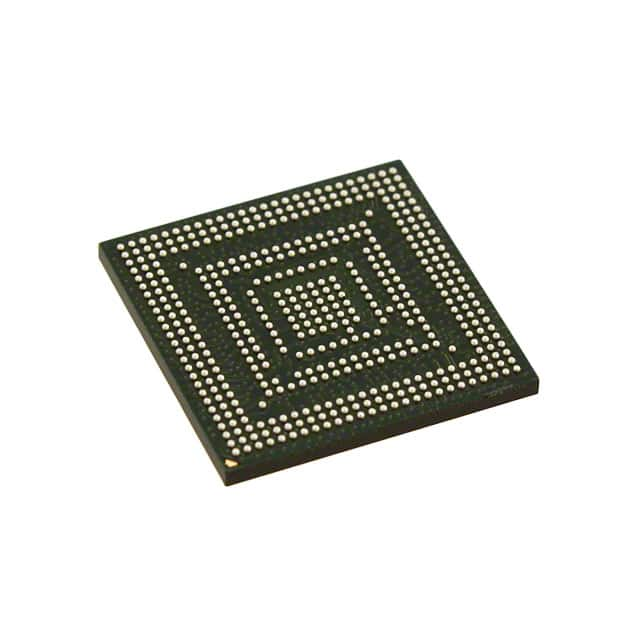Consulte las especificaciones para obtener detalles del producto.

MCIMX31VKN5B
Product Overview
- Category: Integrated Circuit (IC)
- Use: Embedded System Development
- Characteristics: High-performance, Low-power consumption
- Package: BGA (Ball Grid Array)
- Essence: ARM11-based System-on-Chip (SoC)
- Packaging/Quantity: Individual units in anti-static packaging
Specifications
- Processor: ARM1136JF-S core running at 532 MHz
- Memory: 128 KB L2 cache, 16 KB instruction cache, 16 KB data cache
- Connectivity: Ethernet, USB, UART, I2C, SPI, GPIO
- Display: LCD controller supporting up to 1024x768 resolution
- Audio: AC'97 audio codec
- Power Management: Multiple power-saving modes
- Operating Temperature: -40°C to +85°C
Detailed Pin Configuration
The MCIMX31VKN5B has a total of 289 pins. Here is a brief overview of the pin configuration:
- Pins 1-20: Power and ground pins
- Pins 21-50: Processor-related pins (clocks, resets, etc.)
- Pins 51-100: Memory interface pins
- Pins 101-150: Connectivity interface pins
- Pins 151-200: Display-related pins
- Pins 201-250: Audio interface pins
- Pins 251-289: Miscellaneous pins (power management, test/debug, etc.)
For a complete pin configuration diagram, please refer to the product datasheet.
Functional Features
- High-performance ARM11 processor for efficient processing
- Integrated memory caches for improved performance
- Various connectivity options for versatile system integration
- LCD controller with support for high-resolution displays
- AC'97 audio codec for audio playback and recording
- Power-saving modes to optimize energy consumption
Advantages and Disadvantages
Advantages: - High processing power for demanding applications - Low-power consumption for extended battery life - Versatile connectivity options for easy integration - Support for high-resolution displays and audio playback - Power-saving modes for optimized energy efficiency
Disadvantages: - Limited memory capacity compared to some other SoCs - BGA package may require specialized equipment for soldering/rework - Relatively higher cost compared to lower-end embedded processors
Working Principles
The MCIMX31VKN5B is based on the ARM11 architecture, which provides a powerful and efficient processing platform. The processor executes instructions fetched from the memory, utilizing the integrated caches to minimize memory access latency. The various connectivity interfaces enable communication with external devices, while the display and audio components facilitate multimedia applications. The power management features help regulate power consumption based on system requirements.
Detailed Application Field Plans
The MCIMX31VKN5B finds applications in various fields, including:
- Embedded Systems: Used as a core component in embedded systems for industrial automation, IoT devices, and consumer electronics.
- Mobile Devices: Integrated into smartphones, tablets, and portable media players for enhanced performance and multimedia capabilities.
- Automotive: Employed in automotive infotainment systems, navigation units, and driver assistance systems.
- Medical Devices: Utilized in medical equipment such as patient monitoring systems, diagnostic devices, and portable medical instruments.
- Industrial Control: Incorporated into control systems for factory automation, robotics, and process control.
Detailed and Complete Alternative Models
- MCIMX31LITE: A lower-cost variant with reduced memory and connectivity options.
- MCIMX31PRO: An enhanced version with additional peripherals and extended temperature range.
- MCIMX31PLUS: A higher-end model with increased memory capacity and advanced multimedia features.
These alternative models cater to different application requirements and offer varying levels of performance and functionality.
Note: The content provided above is a sample structure for an encyclopedia entry. The actual content may vary based on the specific product and its details.
Enumere 10 preguntas y respuestas comunes relacionadas con la aplicación de MCIMX31VKN5B en soluciones técnicas
Sure! Here are 10 common questions and answers related to the application of MCIMX31VKN5B in technical solutions:
Q: What is MCIMX31VKN5B? A: MCIMX31VKN5B is a microprocessor based on the ARM11 architecture, designed for embedded applications.
Q: What are the key features of MCIMX31VKN5B? A: Some key features include a 532 MHz ARM11 core, integrated peripherals like USB, Ethernet, and LCD controller, and support for various communication protocols.
Q: What are the typical applications of MCIMX31VKN5B? A: MCIMX31VKN5B is commonly used in applications such as industrial automation, medical devices, portable multimedia players, and automotive infotainment systems.
Q: What operating systems are supported by MCIMX31VKN5B? A: MCIMX31VKN5B supports various operating systems including Linux, Windows Embedded CE, and Android.
Q: Can MCIMX31VKN5B handle real-time processing requirements? A: Yes, MCIMX31VKN5B has features like an integrated MMU and cache, which enable it to handle real-time processing tasks effectively.
Q: What development tools are available for MCIMX31VKN5B? A: There are several development tools available, including IDEs like Eclipse, compilers like GCC, and debuggers like GDB.
Q: How can I interface external devices with MCIMX31VKN5B? A: MCIMX31VKN5B provides various interfaces such as UART, SPI, I2C, and GPIOs, which can be used to connect and communicate with external devices.
Q: What is the power consumption of MCIMX31VKN5B? A: The power consumption of MCIMX31VKN5B depends on the specific application and usage, but it is generally designed to be power-efficient.
Q: Can MCIMX31VKN5B support multimedia applications? A: Yes, MCIMX31VKN5B has an integrated LCD controller and supports various multimedia codecs, making it suitable for multimedia applications.
Q: Is MCIMX31VKN5B still in production? A: It's best to check with the manufacturer or distributor for the latest information on the availability of MCIMX31VKN5B as it may vary over time.
Please note that these answers are general and may vary depending on the specific implementation and requirements of your technical solution.

